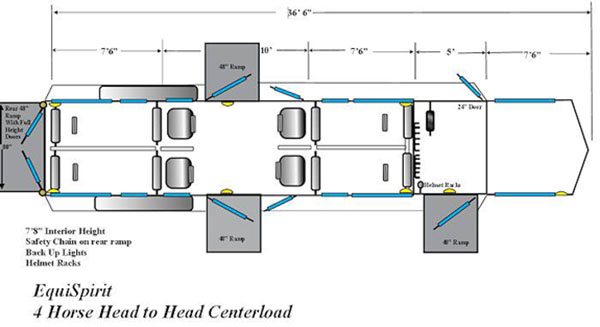Trailer Terms: Straight Load, Slant Load, and Two Plus One
EquiSpirit Trailer Co.
TRAILER TERMS
For first time buyers or those new to owning horses. Here is what you need to know:
QUICK TIPS
BUMPER PULL /TAG-ALONG are terms used for trailers that are coupled to a ball that extends from a hitch that is installed directly onto the tow vehicle’s frame behind the axles. Tag-along is a more appropriate term than bumper bull since a horse trailer should never be coupled to a ball on a bumper. Towing a tag-along carrying up to two horses is safe if hitched correctly to an appropriate tow vehicle. Click here to check out a 2 Horse Bumper Pull Trailer.
GOOSENECK describes a trailer in which 7-1/2 feet is added to the front of the trailer that is shortened in height so that it can extend out over the truck bed and be coupled to a ball and hitch mounted over (or slightly in front) of the rear truck axles. It should always be used for towing more than two horses. Click here to check out a Two Horse Gooseneck Trailers.
STRAIGHT LOAD refers to any trailer where the stalls are straight rather than at an angle. STRAIGHT LOAD WALK THROUGH is the common term used for a horse trailers where the stalls face towards the front, the horse head area is unrestricted (reducing claustrophobia), and side doors that open into the front stall area, provide easy and safe access and exits for the person(s) loading and towing the horses – hence the reason they are called walk throughs. The doors can also be used as emergency exits for the horses if designed for that purpose. Click here to see a Straight Load floor plan.
MANGER is the term used for straight load trailers with built-in compartments under the horses’ heads and in front of the horses’ legs. Lower exterior access doors allow for saddles and tack to be stored. Upper access doors open into the horses’ head area where hay can be fed to the horses by laying it on top of the compartment, which is called a manger. Half doors are often placed over the front of each fender giving access into the stall area. Although the placement, fender and door size make them difficult to use. Because of the potential danger of a horse getting a leg on top of the manger, we do not build or recommend them.
SLANT LOAD describes a trailer that has stalls angled from side wall to side wall rather than from front to back. Larger horses do not fit comfortably in most slant stalls because DOT limits the legal width to 102 inches, therefore limiting the length of the interior stalls. We don’t recommend Slant Load trailers. Click here to learn why.
TWO PLUS ONE refers to gooseneck trailer that has two rear stalls and one large front box stall that can carry a third horse. It has at least one side load/unload ramp into the front stall area. Its overall design allows for each horse to be loaded/unloaded individually without disturbing the others. Click here to view a Two Plus One floor plan.
CENTER LOAD or HEAD TO HEAD refers to a four or six horse gooseneck trailer that has side by side straight stalls in the rear of a trailer that face forward with the same configuration in the front except the stalls face towards the rear. A large center area will have one or two side ramps for loading and unloading. This style also allows each horse to be loaded and unloaded individually. Click here to see a Center Load floor plan.
If you would like to learn more trailer terms, simply click here.











